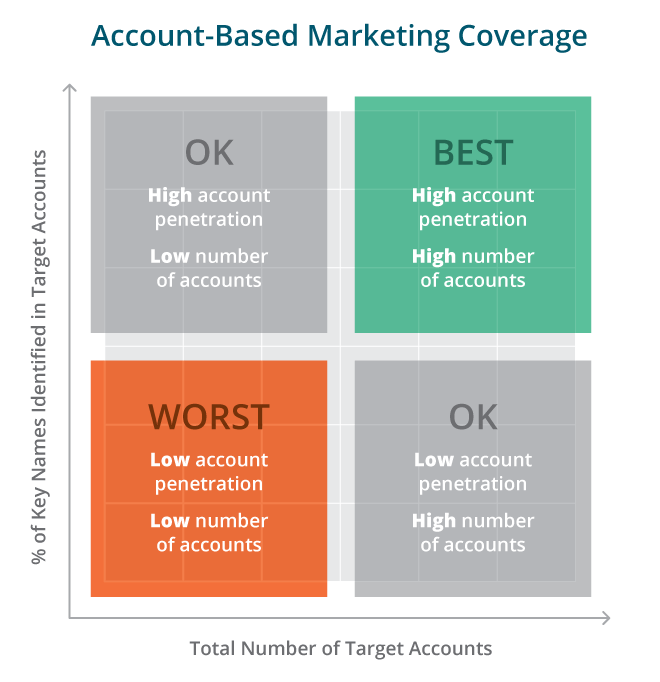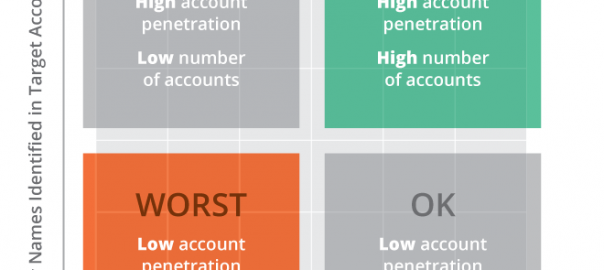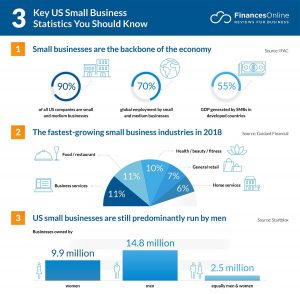— March 22, 2018

We’ve all heard the news— Account Based Marketing, or ABM, is an incredibly effective way to target prospects and close more deals. In fact, companies with an ABM strategy in place generate 208% more revenue for their marketing efforts than companies without an ABM strategy (source). But—you already knew that.
Now that ABM has proven to be more than just a passing trend, it’s time to take it to the next level. Today’s blog post explores five key metrics to consider before your next ABM campaign. Keep reading!
5 Metrics that Could Make or Break Your Next ABM Campaign
1. Account Coverage
Let’s start with account coverage—a phrase that refers to a team’s ability to both identify and penetrate a large number of key accounts. Here’s why account coverage is important: If you have many target accounts with low levels of penetration, you’ll have a difficult time converting those accounts to customers.
On the other hand, if you only have a few target accounts with optimal account penetration, you’ll only ever be able to close a few deals. Here’s what we mean:

Use these two primary metrics to understand account coverage:
- Percentage of key personnel you’ve engaged with from each account.
- Percentage of accounts you’ve engaged with from within your target market.
As you implement more campaigns and scale your ABM efforts over time, you’ll get a better understanding of what an ideal percentage looks like for both of these items. What’s most important, however, is that you see a general upward trend—meaning you’re engaging with more contacts within your accounts while simultaneously increasing the number of key accounts on your radar.
2. Account Quality
Arguably even more important than account coverage is our next metric: account quality. Consider this scenario: you’ve identified over 1,000 target accounts and initiated positive engagement with important contacts from over 75% of them—yet, in the end, your efforts generate lackluster results. What gives?
The answer: poor account quality. You can have perfect account coverage, but if your account targeting strategy is off, you’ll never achieve the results you’re looking for.
Just as you would while prospecting, you must do your research and determine which qualities make an account a good fit for your product. Is it the size of the company? The revenue they generate each month? Or is it the fact that they use a certain set of technologies to run their business?
Once you’ve developed an ideal customer profile or a set of buyer personas, analyze how well your target accounts match up to these standards. We recommend that you actually score each account as you would score a singular lead.
Here’s how you do it: If your ideal customers generate X amount of revenue, have X amount of employees, work in X industry, and don’t currently have a product like yours, they receive a score of ‘100’. For every marker they miss, they go down ten points.
Later on, when we discuss engagement, this score will become important.
3. Opportunities and Revenue
Typically, a marketer’s success lies within their ability to generate leads. With an account-based approach, however, leads become less important. This is largely due to the fact that multiple leads can come from within a single account—which then shifts the value more towards the account itself.
For this reason, we recommend you focus more on the opportunities created and the revenue generated by your account-based efforts. This concept is referred to as “Account Based Revenue,” a phrase coined by ABM pro, Trish Bertuzzi.
The idea behind account-based revenue (instead of Account Based Marketing) is to purposely break down the silos between the two departments, ultimately better aligning marketing and sales and generating more revenue for your company.
Now, instead of leads, you can use revenue and sales opportunities to accurately evaluate your account coverage and quality. It’s a no-brainer.
4. Account Engagement
We’ve already stressed the importance of quality over quantity when it comes to ABM—and account engagement is no exception to this rule. More traditional marketing methodology might look at a campaign that generates 1,000 engagements and deem it a success. But, with ABM, the number of engagements no longer matters. What’s more important is who’s doing the engaging, the length of the engagement, and how meaningful the interactions are.
Take a direct mail ABM campaign for example: an HR software company takes the time and effort to send a targeted gift package to HR directors within their top accounts. The unique landing page created for the campaign receives thousands of hits—but ultimately the campaign generates very little revenue.
Here’s why: upon receiving the gift package, HR directors handed it over to receptionists and secretaries without a second glance. So, while engagement was high, it wasn’t coming from the intended audience.
We recommend this: Prior to deploying a new ABM campaign, establish what successful engagement looks like. Does the person have a specific job title? Do they respond to a certain CTA? Does the time they spend on a certain page matter? Once you’ve defined successful engagement, it becomes much easier to measure.
5. Improvement over time.
Although not as specific as other metrics covered in this post, a key part of Account Based Marketing is analyzing your results and adjusting your campaigns to be more successful the next time around.
The way to generate more revenue, engage better accounts, and close more deals is to use what you’ve already done and apply it to future endeavors. You may not get it right the first time around but, as long as you make strategic, data-driven improvements, you’ll make progress.
Take engagement for example. If you notice multiple visits to your website from the IP address of a target account, but time-on-page is dismal, you know something is wrong with your landing pages. Maybe it’s your content. Maybe your offer isn’t compelling. Or, maybe it’s the imagery your use. Test one thing at a time and be methodical about your strategy. As you learn what works, your campaigns will improve.
Key Takeaways
These are just few metrics that can make or break the success of your Account Based Marketing strategies. But remember, success will be measured differently depending on your specific campaigns and goals. We recommend that you start every campaign with a clear goal and a defined set of metrics you intend to monitor.
Setting aside specifics, the overall key to ABM success lies within your ability to treat each company or account like an audience of one. How well you hone in on that specific company’s interests, needs, and pain points will determine how successful you are.
Business & Finance Articles on Business 2 Community
(92)
Report Post





